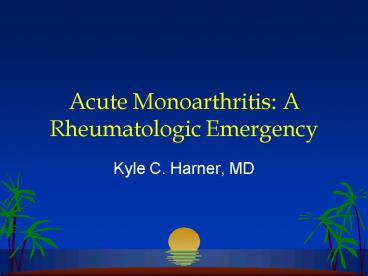Acute Monoarthritis: A Rheumatologic Emergency - PowerPoint PPT Presentation
1 / 10
Title:
Acute Monoarthritis: A Rheumatologic Emergency
Description:
Gout (monosodium urate crystals) most common - First MTP, ankle, midfoot, knee ... 90% PMNs despite count, concern for gout/septic joint ... – PowerPoint PPT presentation
Number of Views:626
Avg rating:3.0/5.0
Title: Acute Monoarthritis: A Rheumatologic Emergency
1
Acute Monoarthritis A Rheumatologic Emergency
- Kyle C. Harner, MD
2
References
- Baker and Schumacher, Acute Monoarthritis. NEJM
1993 Sept 30329(14) 1013-20. - Freed et al, Acute Monoarticular arthritis. A
diagnostic approach. JAMA 1980 June 13
243(22) 2314-6. - Towheed and Hochberg, Acute Monoarthritis a
practical approach to assessment and
treatment. Am Fam Physician 1996 Nov 15
54(7) 2239-43.
3
Differential Diagnosis
- Infectious arthritis ()
- Crystal-induced arthritis ()
- Trauma ()
- Osteoarthritis
- Osteonecrosis
- Foreign-body reaction
- Tumor
- Presentation of systematic disease Three most
common causes
4
Infectious Arthritis
- Most serious cause of monoarthritis, can destroy
cartilage in one to two days - Non-gonococcal are most serious - most
common in knees and hips - sternoclavicular
joints in IV drug users - most febrile but do
not appear especially ill - 90 monoarticular,
hematogenous spread - 80 Gram() anaerobes
60 S. Aureus (most PCN, some meth
resistant) 15 Non-group A, beta-hemolytic
strep 3 Strep pneumo - 18
Gram(-) - Anearobes on rise in IV drug
users/immunocompromised
5
Infectious Arthritis (cont.)
- Gonococcal - Women men - Often
proceeded by migratory tendonitis/arthritis -
Much less destructive as extremely sensitive to
ABX - Cephalosporins standard of care now, due
to PCN resistant strains - Synovial fluid
culture only positive in 25 of cases - Tuberculous - Most often chronic, but
reported acute cases - Pulmonary TB on seen in
50 of patients w/ joint findings - PPD usually
positive - Fungal
- Viral (such as herpes simplex and HIV)
- Lyme - characteristic acute oligoarthritis
6
Crystal-induced Arthritis
- Gout (monosodium urate crystals) most common -
First MTP, ankle, midfoot, knee (can be any joint
though) - Most initial attacks affect a single
joint - Fever (more common with polyarticular)
can raise suspicion for infection -
Presence of crystal does not exclude
infection - May see desquamation of overlying
skin - Thiazide diuretics can put at risk -
Needle shaped, negatively birefringent crystals - Calcium pyrophosphate dihydrate/pseudogout -
Clinically not able to distinguish from gout -
Most common in knee and wrists - Evolves over
several days (less acute than gout) - Rhomboid
shaped, positively birefringent crystals - Other crystals apatite, calcium oxalate, liquid
lipid
7
Other causes
- Osteoarthritis - acutely worse and swollen in
single joint (overuse) - Osteonecrosis - common in elderly, sudden onset
of pain or swelling in single joint with or
without effusion - Hemarthrosis (bleeding into joint) - most common
in folks with acquired or congenital clotting
problems (such as hemophilia) - Penetrating injuries (wood fragments, thorns) can
lead to foreign body reaction - Prosthetic joint - infection most likely due to
seeding from skin source, crystal disease is
rare. Loosening is most common cause of pain - RA, SLE, IBD, Psoriatic arthritis, Behcets,
Reiters - Idiopathic (relatively good prognosis for
undiagnosed cases)
8
Approach to the Patient
- Previous history - crystal induced versus
non-infectious - Fever, tick bites, sexual risk factors, IV drug
use, travel, trauma - Sx rash, diarrhea, urethritis, uveitis
- PE joint (rubor/dolor/calor/tumor), ulcers
(Behcets, Reiters, SLE), psoriasis, erythema
nodosum (SLE, sarcoidosis, IBD), splinter
hemorrhages (bacterial endocarditis) - Radiographs - not often helpful in establishing
diagnosis - Culture and gram stain of joint and any other
lesions - HIV and lyme titer if indicated
- RF, ANA, and acute uric acid not often helpful
- Arthrocentesis (only need 1 to 2 cc) in almost
all patients, send fluid for crystals, gram
stain/culture, cell count - Rarely need to proceed to arthroscopy/synovial
biopsy
9
Synovial fluid cell count interpretation
- Leukocyte count 2000 2000-20,00
0 20,000-50,000 50,000 100,000 - 90 PMNs despite count, concern for gout/septic
joint
- Interpretation Normal Non-inflammatory Inflammat
ory Mild inflam (SLE) Mod. inflam
(RA) Severe(gout,septic) Septic, until
proven otherwise
10
Treatment
- Treat for gram() infection including
methicillin-resistant staph. and strep. - Treat for gram(-) as well in immunocompromised
patients and patients with gram(-) source - IV Ceftriaxone for gonococcal arthritis (most
areas) - Daily closed drainage until effusion is gone
- Consider open drainage if response to IV
antibiotics is slow or if joint can not be
aspirated (? arthroscopic drainage in some
centers) - Culture negative, ? stop antibiotics
- Joint rest, ice, PT































